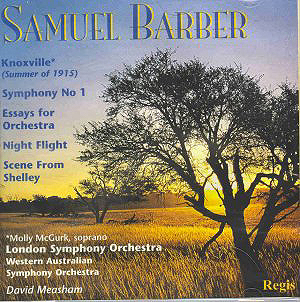In
repertoire terms David Measham was to commercial recording what
Norman Del Mar was to the radio studio. Del Mar's studio-taped
programmes were unafraid of unfashionable choices - mixing Balakirev,
Shostakovich, Seiber, Lambert, Bax, Searle and Strauss. Measham
was one of Unicorn's regulars during the 1970s recording with
them Josephs (Requiem and Pastoral Symphony), Goossens
(Symphony No. 1), Miaskovsky (Symphony No. 21), Kabalevsky (Symphony
No. 2) and Barber among others. His Barber was true to romantic
type: humid, perfervid; hothouse stuff put across with tireless
confidence and full response to variety of mood.
Regis
faced a timing problem in re-running these tapes. The two Barber
Unicorn LPs were made up of the LSO collection RHS 342 (Symphony,
Essays and Night Flight) and the WASO LP UNS256
(Knoxville, Violin Concerto and Shelley Scene).
This was too much for one CD. What to omit? The final choice fell
on the Violin Concerto. Although a fine performance the shelves
already groan with excellent readings of the concerto. Recordings
of Knoxville are not quite so common. It is a while since
I heard the versions by Leontyne Price and Barbara Hendricks,
however Molly McGurk is a sensitive singer and has the necessary
heft for the big moments. More to the point you can fully believe
her assumption of the child's viewpoint central to James Agee's
meditation. Steber's classic recording now sounds a mite shrill
but the closest approach to perfection is Dawn Upshaw's on Teldec
- a pity it was never tackled by Netania Davrath. McGurk's voice
has the operatic 'chops' for the work's stormy crests yet has
enough innocence to do justice to the predominantly childlike
viewpoint. Barber chose or was chosen by this hardly apt text
and made of it a masterpiece that quickly gets under the skin.
The
other works are very much of a piece in mood. The clouds lour,
great passionate oratory breathes through the pages. Even the
Barber works of the 1940s remain in touch with the cliff-edge
passions and tragedy of the symphonic 1930s. The Symphony belongs
to the world of Walton's First, Rubbra's First, RVW's Fourth and
Bax's Sixth. It is a shade melodramatic but this is not its weakness;
for that we must look to the lack of indelibly memorable themes.
It is still a work with a potent emotional charge linking to other
Rome-based pieces such as Hanson's First and Second Symphonies.
Gershwin's Rhapsody in Blue, then continuing to
take the world by storm, is also hinted at at least once. Its
one movement structure points towards the 'recentish' Sibelius
Seventh Symphony. Another much later work indebted to the Barber
is the Flagello Symphony recently issued on Naxos American Classics.
Roy Harris's aggressive syncopated rhythmic inclinations can be
heard from 08.00 onwards.
Essay
No. 1 with its dour Slavonic intensity suffers from lack of
memorable themes. However the burnished Second Essay
is superb (listen to the coarsened French Horns at 3.58) as also
is the very early Shelley work with its happy fusion
of beauty and dramatic statement. Night Flight is
more subdued; more concentrated and its portrayal of romantic
loneliness (based on 'Vol de Nuit' by Antoine de Saint Exupéry,
the author of 'Wind, Sand and Stars' and 'The Little Prince')
is intensified by the ‘pecking’ piano motif representing the radio
beacon that keeps the pilot on course for home. It is a superb
piece. It can now be heard in its proper context in Marin Alsop's
Naxos CD of the two symphonies and also directed by Barber on
Pearl. The Shelley Scene has some decidedly Sibelian
moments including several references to ideas paralleled in the
Fifth Symphony. It is a fine and well formed work which, just
like the Essays, could just as easily have served as movements
in a Symphony.
The
LSO tracks are superb and possibly speak not just of Measham's
coaching but of Previn's sovereign years with them. The sessions
took place while Previn was still in 'office' there.
Regis's
cover designs can seem clunky suggesting their bargain basement
placement. In this case however a sure eye for pleasing colour
and object symmetry/consonance is evident; one of their very best
This
is a smashing Barber orchestral collection in which the superheated
radiance of the orchestral works of the 1930s and 1940s contrasts
with the distilled nostalgia of Knoxville, his most penetratingly
poignant and moving work - yes, even taking account of the Adagio.
Rob
Barnett
